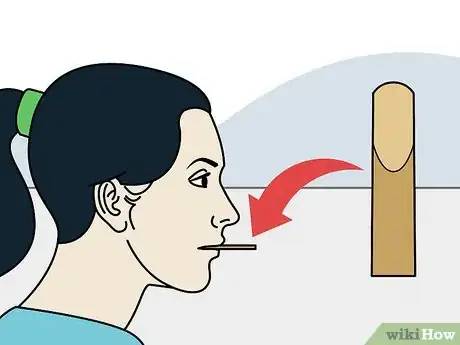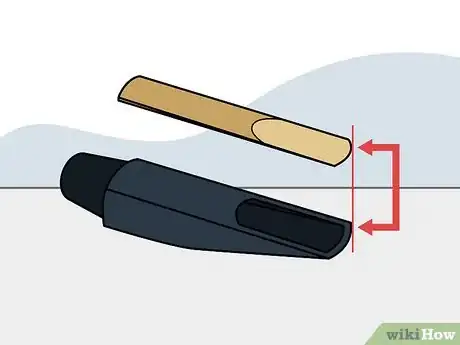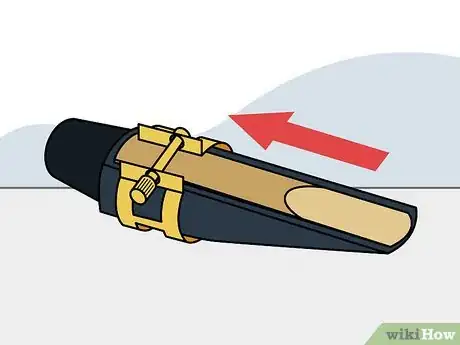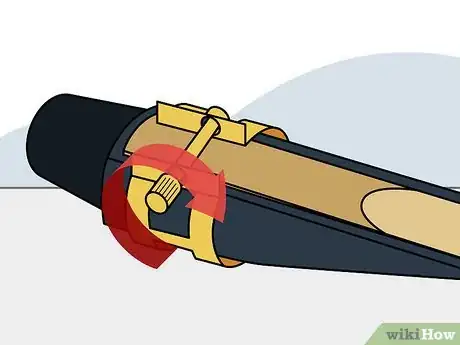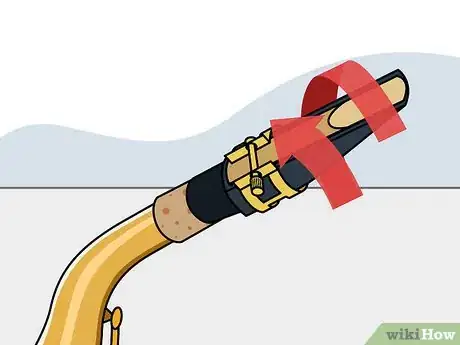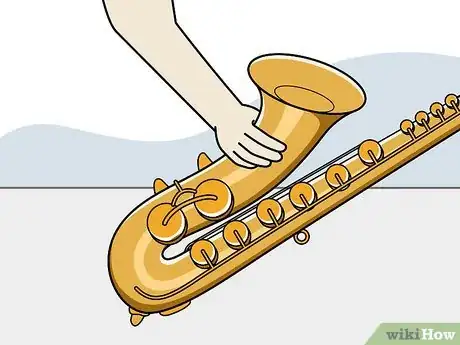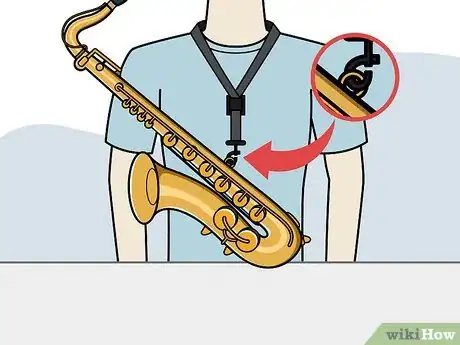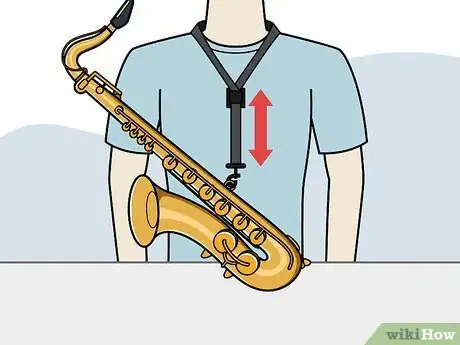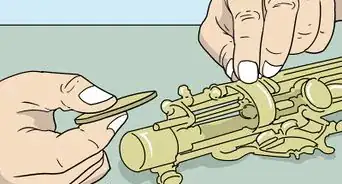This article was co-authored by wikiHow Staff. Our trained team of editors and researchers validate articles for accuracy and comprehensiveness. wikiHow's Content Management Team carefully monitors the work from our editorial staff to ensure that each article is backed by trusted research and meets our high quality standards.
This article has been viewed 177,927 times.
Learn more...
The saxophone is a fairly easy instrument to put together, especially once you get the hang of attaching the reed. There are delicate pieces on the instrument, so you have to be careful about how much pressure you use while handling it and pushing the parts together. Start by assembling the mouthpiece, and then move on to connecting the larger pieces.
Steps
Assembling the Mouthpiece
-
1Moisten your reed by placing it on your tongue. Place one end of the reed in your mouth and allow your saliva to moisten it for about a minute. Then turn the reed around and moisten the other end in your mouth for a minute. Be careful not to cut your tongue since reeds sometimes have sharp edges.
- You could also just soak the reed in a cup of water for a couple of minutes.
-
2Line up the curved tip of the reed with the curved tip of the mouthpiece. Take the reed out of your mouth and place its flat side against the flat part of the mouthpiece. The thin, curved end of the reed should line up exactly with the thin, curved tip of the mouthpiece.[1]
- If it's not lined up properly, the saxophone will make a squeaking noise when you blow air through it.
Advertisement -
3Slide the ligature onto the mouthpiece and over the reed. Make sure that the wider end of the ligature slides on first to match the shape of the mouthpiece. Hold the reed in place with your thumb while you line the ligature up with the widest part of the mouthpiece. If the ligature is too tight to fit over the reed, loosen it by turning the screws counterclockwise.
- The screws should be on the thick bottom part of the reed.
- A little bit of the reed will extend past the bottom of the ligature.
-
4Tighten the ligature by twisting the screws. Still holding the reed in place with your thumb, use your other hand to tighten the ligature. Turn the screws clockwise until you feel a little bit of resistance. It should be just tight enough that the reed can no longer move around. Do not tighten past this point since you could damage the reed.[2]
Putting the Large Parts Together
-
1Put the neck strap around your neck. Let the neck strap rest around your neck like a necklace. Make sure the hook is hanging over your chest at the front of the strap. Wait to make adjustments to its length until you have the saxophone attached to it.
-
2Apply cork grease to the saxophone neck as needed. Occasionally you’ll need to rub a little bit of cork grease onto the cork part of your saxophone’s neck. Apply a very small amount all the way around the tip of the cork whenever the mouthpiece stops sliding onto the neck easily.
- You can get tubes of cork grease at music stores or online.
-
3Twist the fully assembled mouthpiece onto the neck. Use a gentle, back-and-forth twisting motion to get the mouthpiece onto the neck of the sax. Twist it on until it’s about halfway down the length of the cork. The flat side with the reed on it should face down toward the inside of the neck.
- If you’re having trouble getting it on, and you’ve already applied cork grease, don’t force the parts together. Take it to a repair shop to have it looked at by a professional.[3]
-
4Pick up your saxophone by the bell. Picking up your sax by the upper body can cause damage to the mechanisms that make the instrument work properly. Wrap your fingers around the outside of the bell, where there are no keys, and grip this area as you lift it.
-
5Hook the neck strap onto the small loop on the back of the body. Below the octave key, about halfway down the saxophone, there’s a small metal loop. Connect the neck strap to this loop by opening the hook and fastening it over the loop.
-
6Slide the neck into the body. Using the same back-and-forth twisting motion, press the neck down into the body until it’s all the way on. The tip of the mouthpiece should line up perfectly with the rest of the horn and create one straight line from the reed to the bell.[4]
- If you can’t slide the neck right into the body, try loosening the wing nut at the top of the body by turning it counterclockwise.
- Do not force the neck on. Consult a repair shop if you’re having difficulty getting the pieces together.
- Be careful to not damage the octave key built onto the neck when you’re assembling.
-
7Adjust the neck strap as needed. Hold the assembled saxophone in front of you and loosen your grip on it so that the neck strap bears most of the weight of the instrument. If the mouthpiece is suddenly lower than you mouth, adjust the neck strap up. If it’s higher than your mouth, adjust the neck strap down. The strap should hold the saxophone exactly where it will be while you’re playing it.
Community Q&A
-
QuestionHow far should reed be on the mouthpiece?Put it far enough that you can see about a hair's-width of the mouthpiece at the top of the reed.
-
QuestionDo I blow out or suck in to make noise?
 Community AnswerBlow out! Blowing over a reed causes a certain airflow that makes noise.
Community AnswerBlow out! Blowing over a reed causes a certain airflow that makes noise. -
QuestionHow do you hold the saxophone?
 Community AnswerTo hold it during assembly, hold it by the bell. To learn how to hold it while playing, consult the Wikihow article "How to Play the Alto Saxophone"
Community AnswerTo hold it during assembly, hold it by the bell. To learn how to hold it while playing, consult the Wikihow article "How to Play the Alto Saxophone"
References
About This Article
To assemble a saxophone, line up the curved tip of the reed with the curved tip of the mouthpiece, then slide the ligature onto the mouthpiece and twist the screws to tighten it. Next, twist the assembled mouthpiece onto the saxophone's neck using a gentle, back-and-forth twisting motion. Then, pick up your saxophone by the bell and slide the neck piece into the body. Finally, adjust the neck strap until you feel comfortable holding the sax! For tips on greasing the neck, read on!
